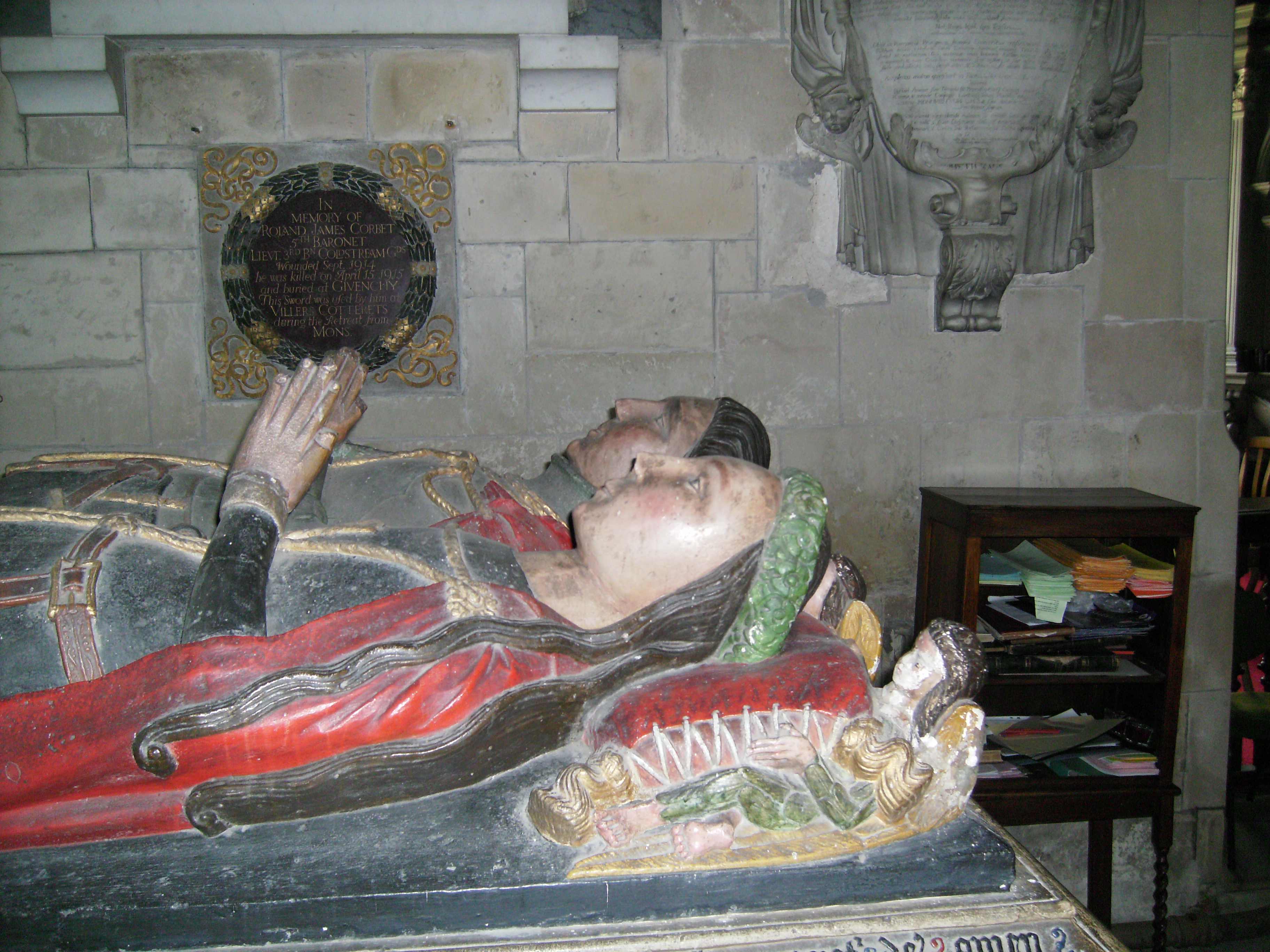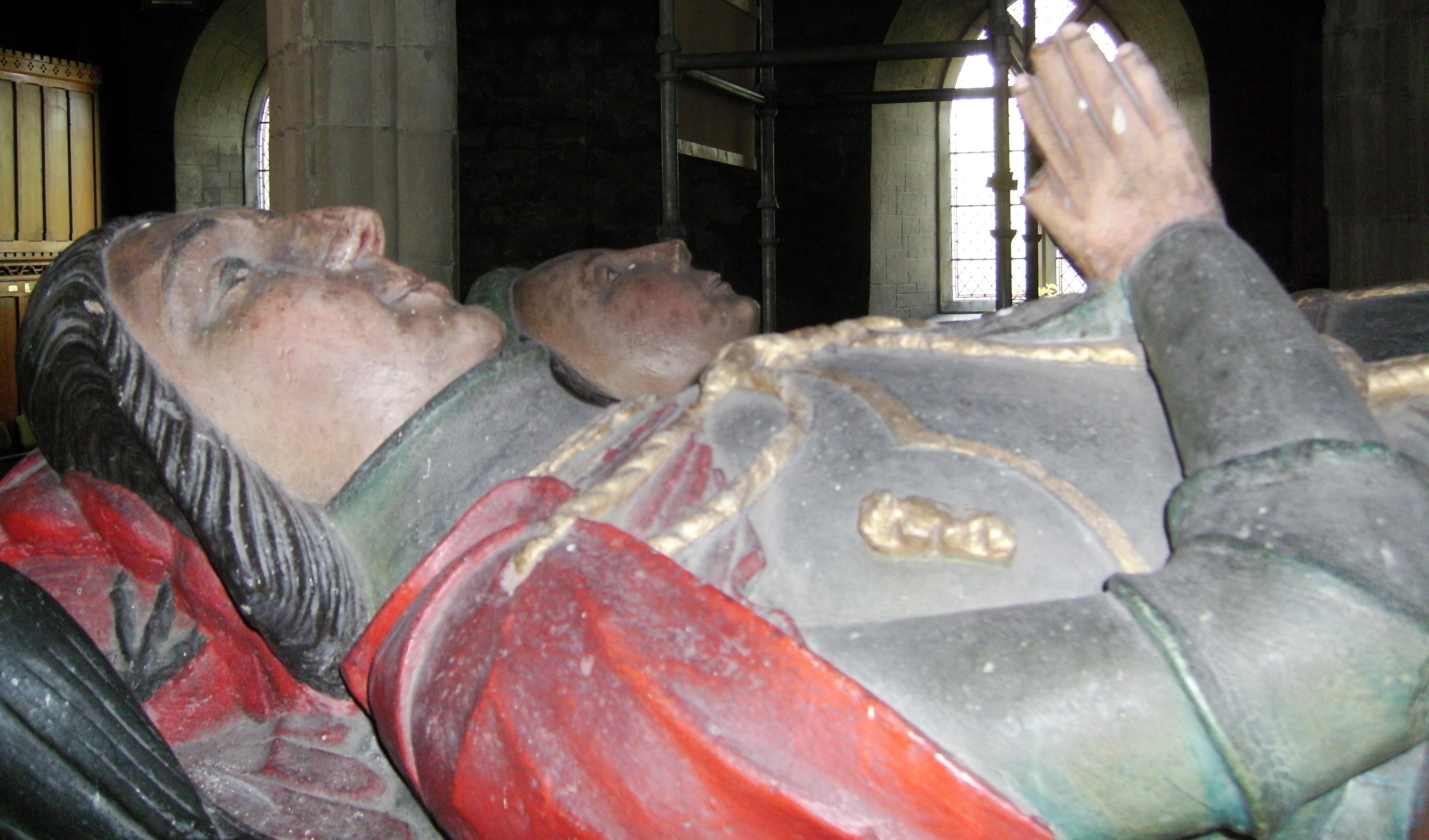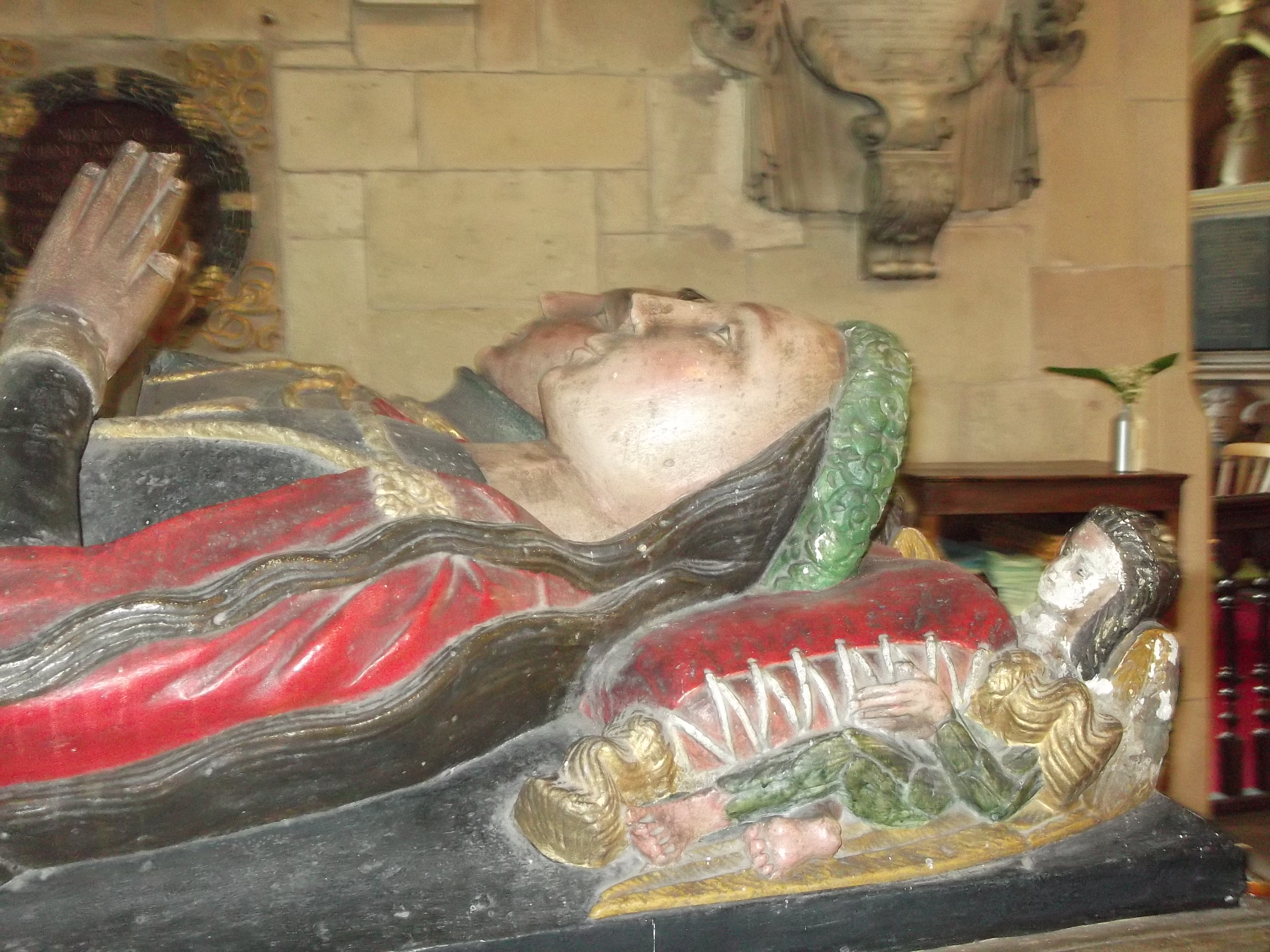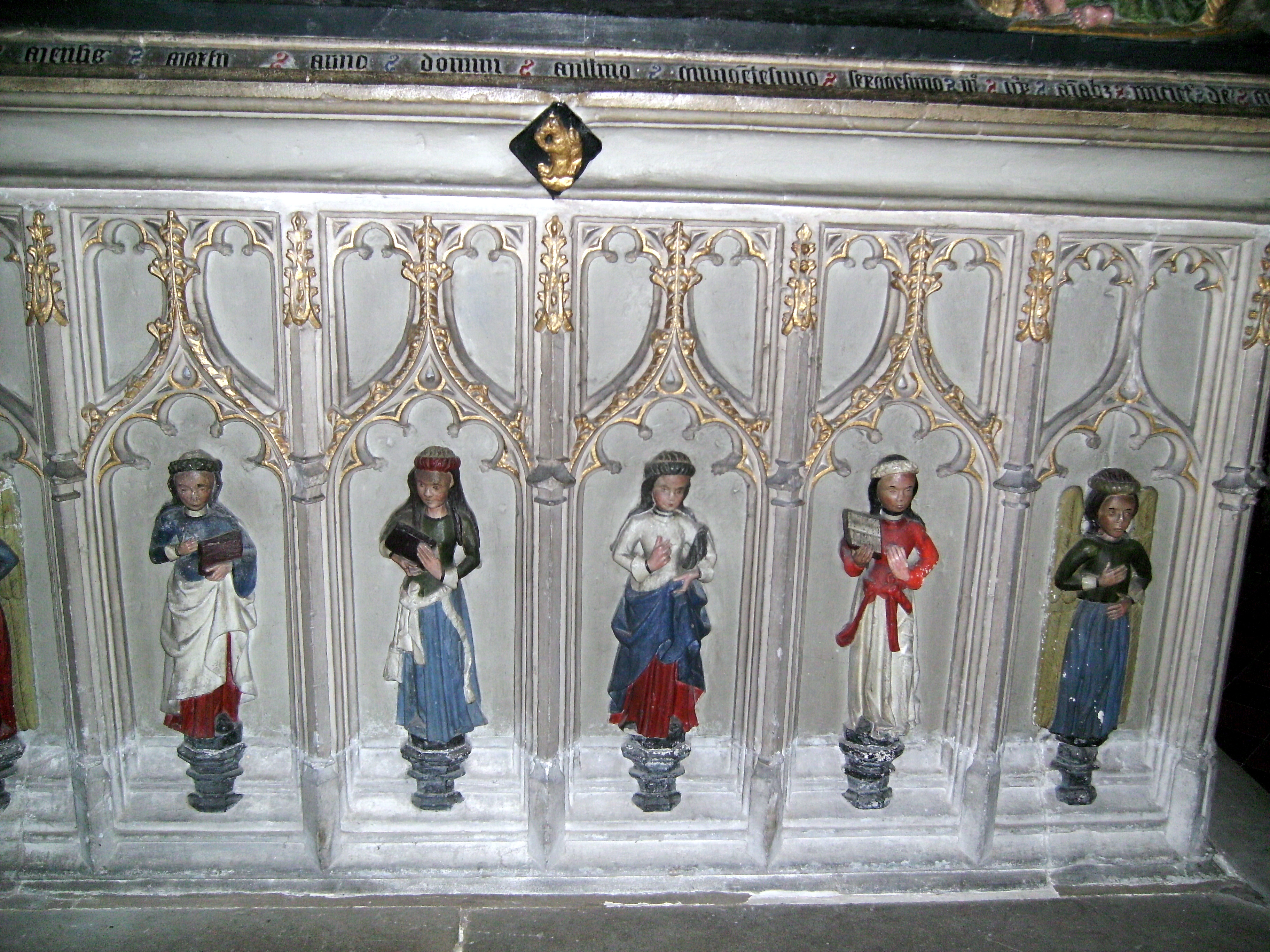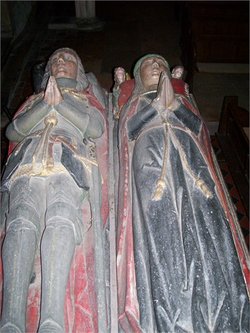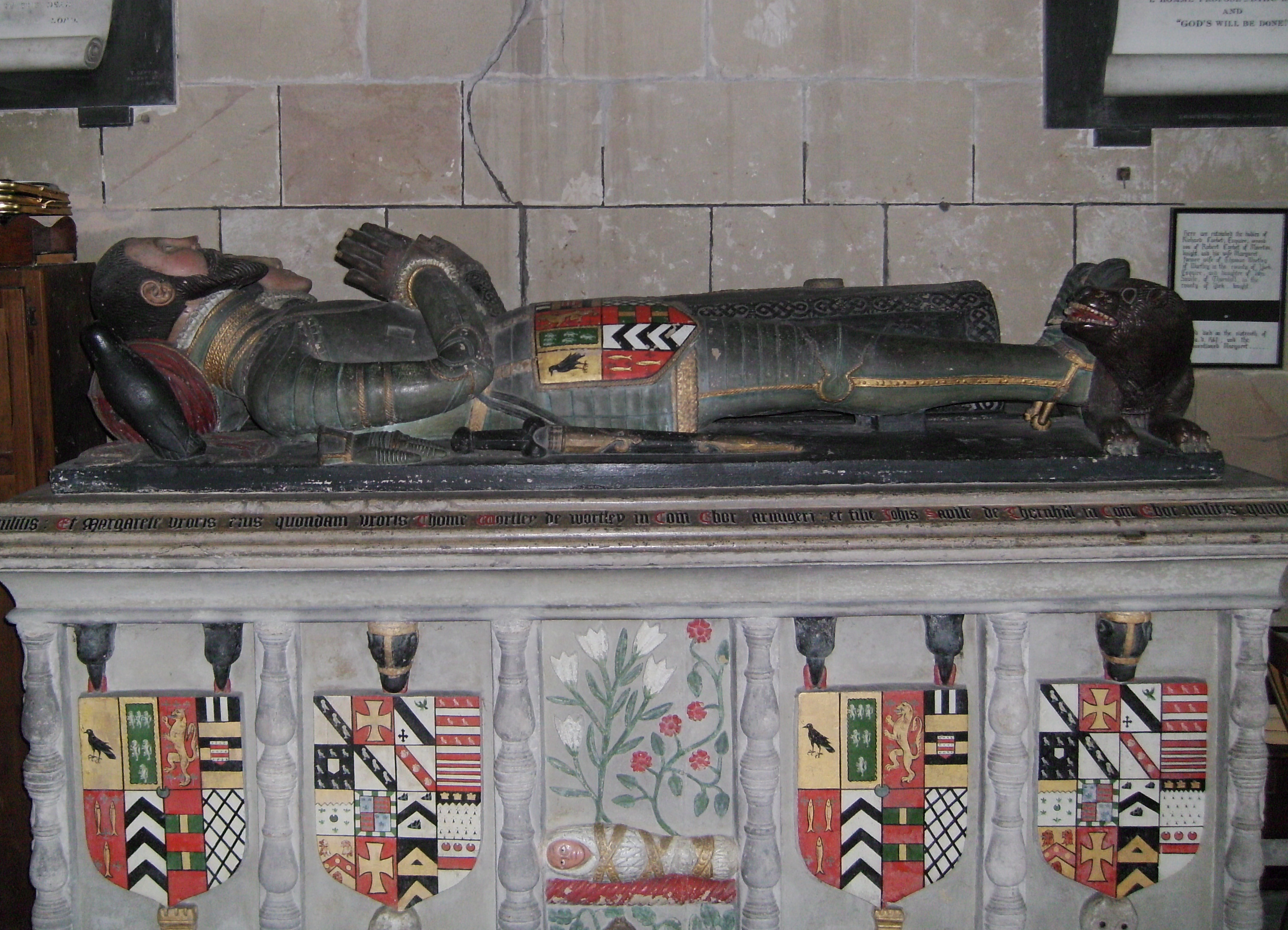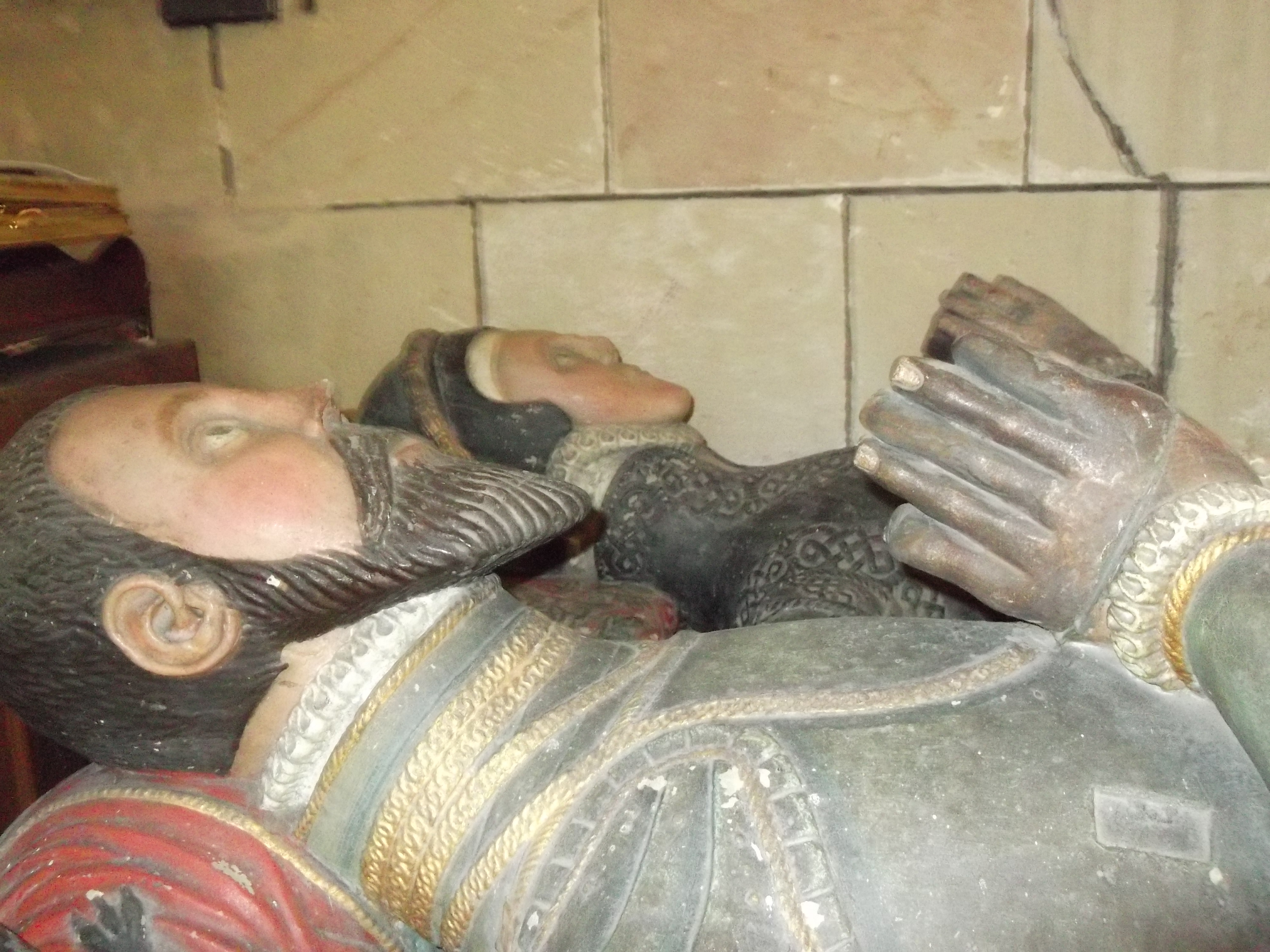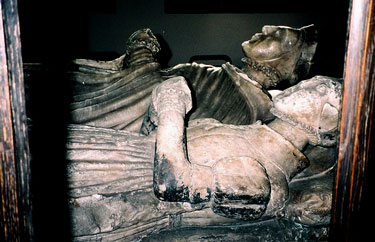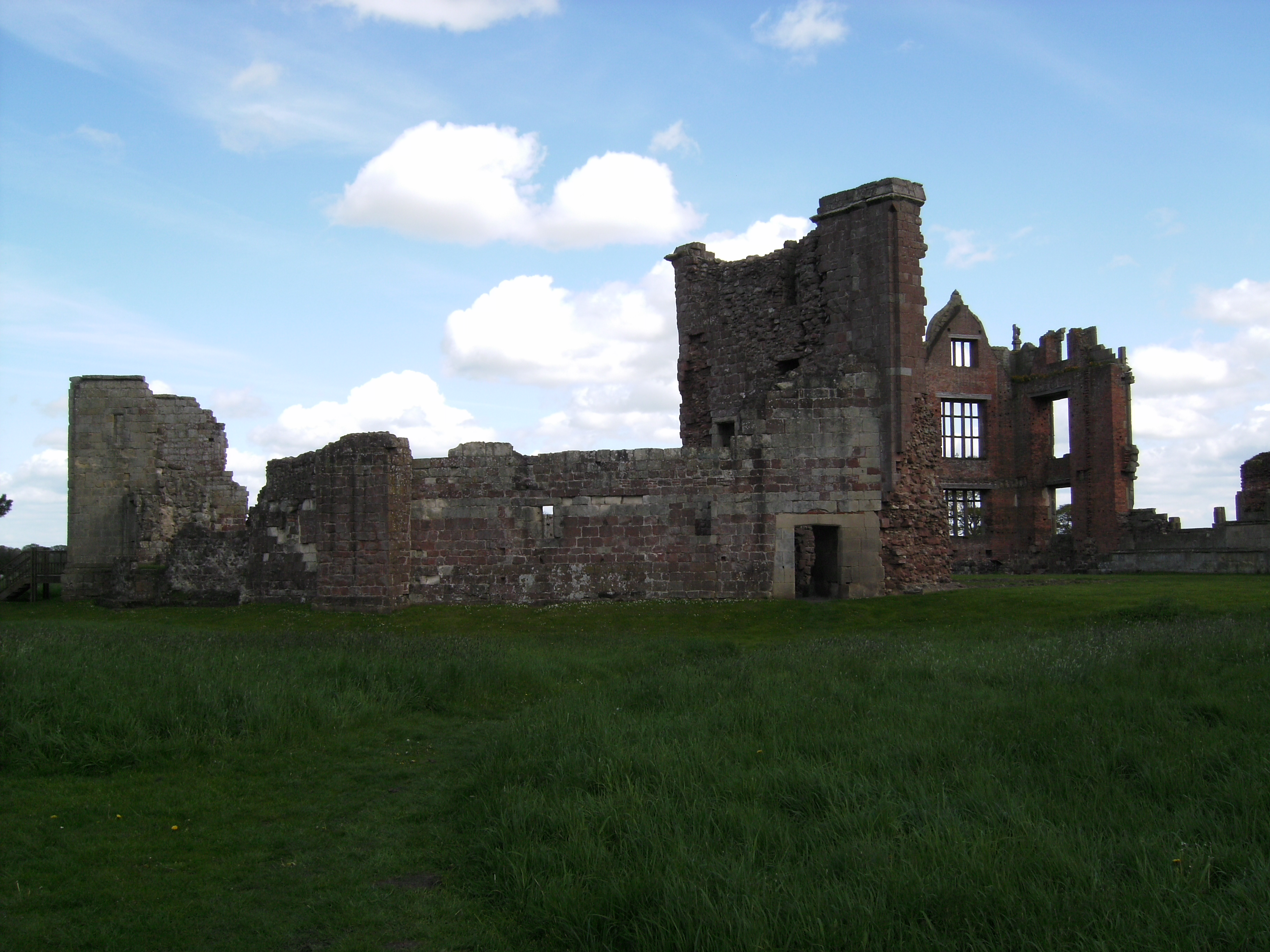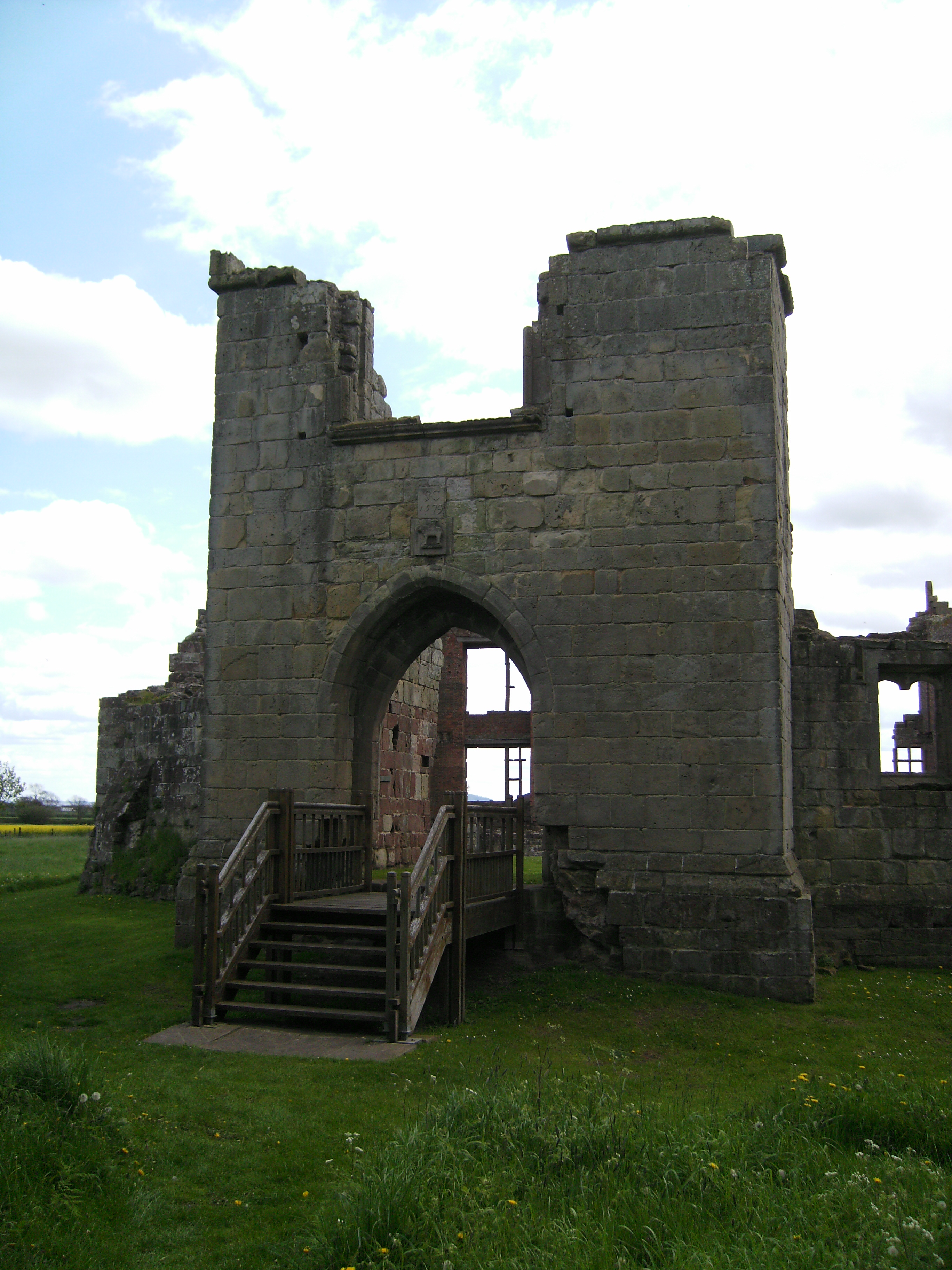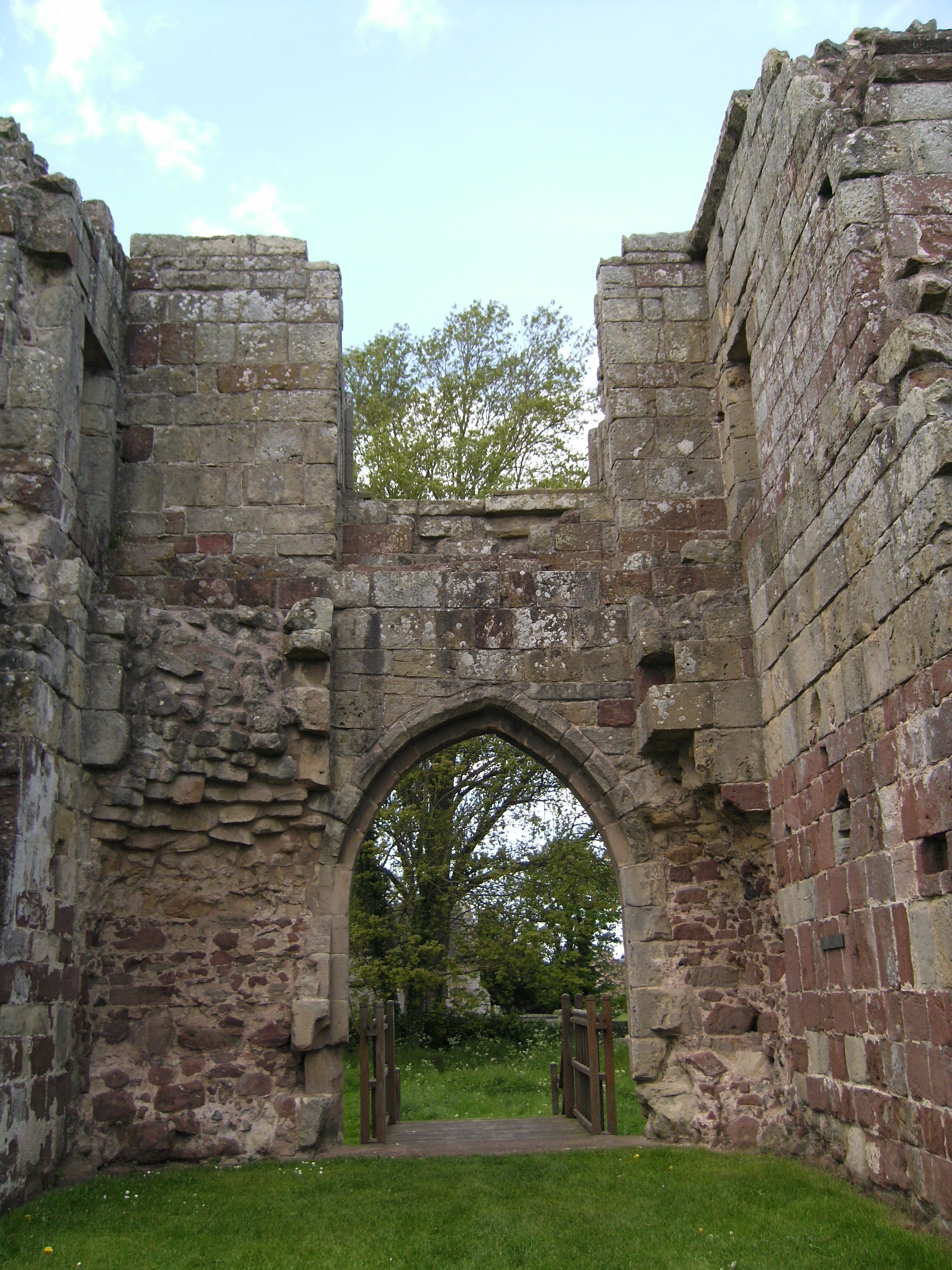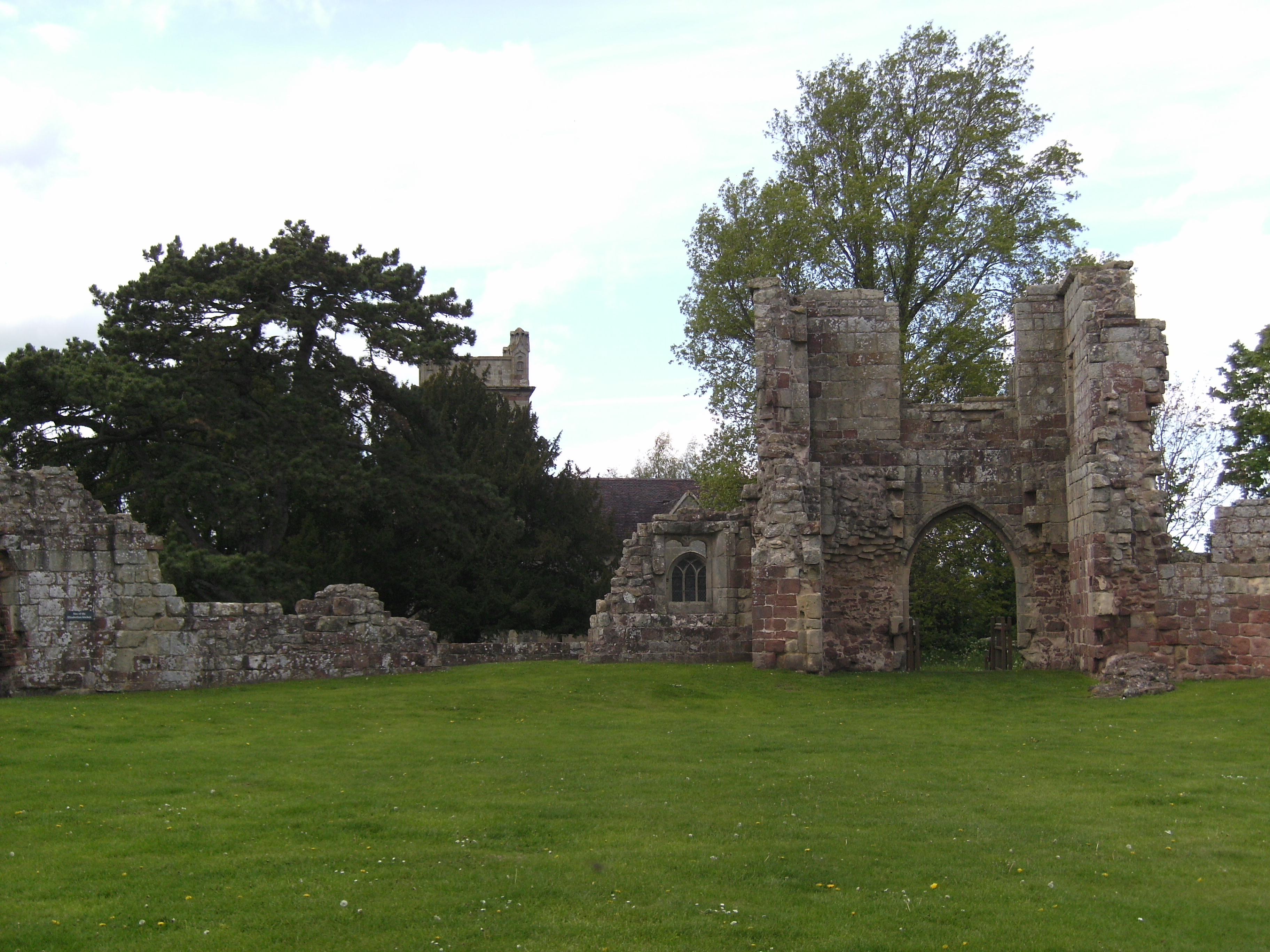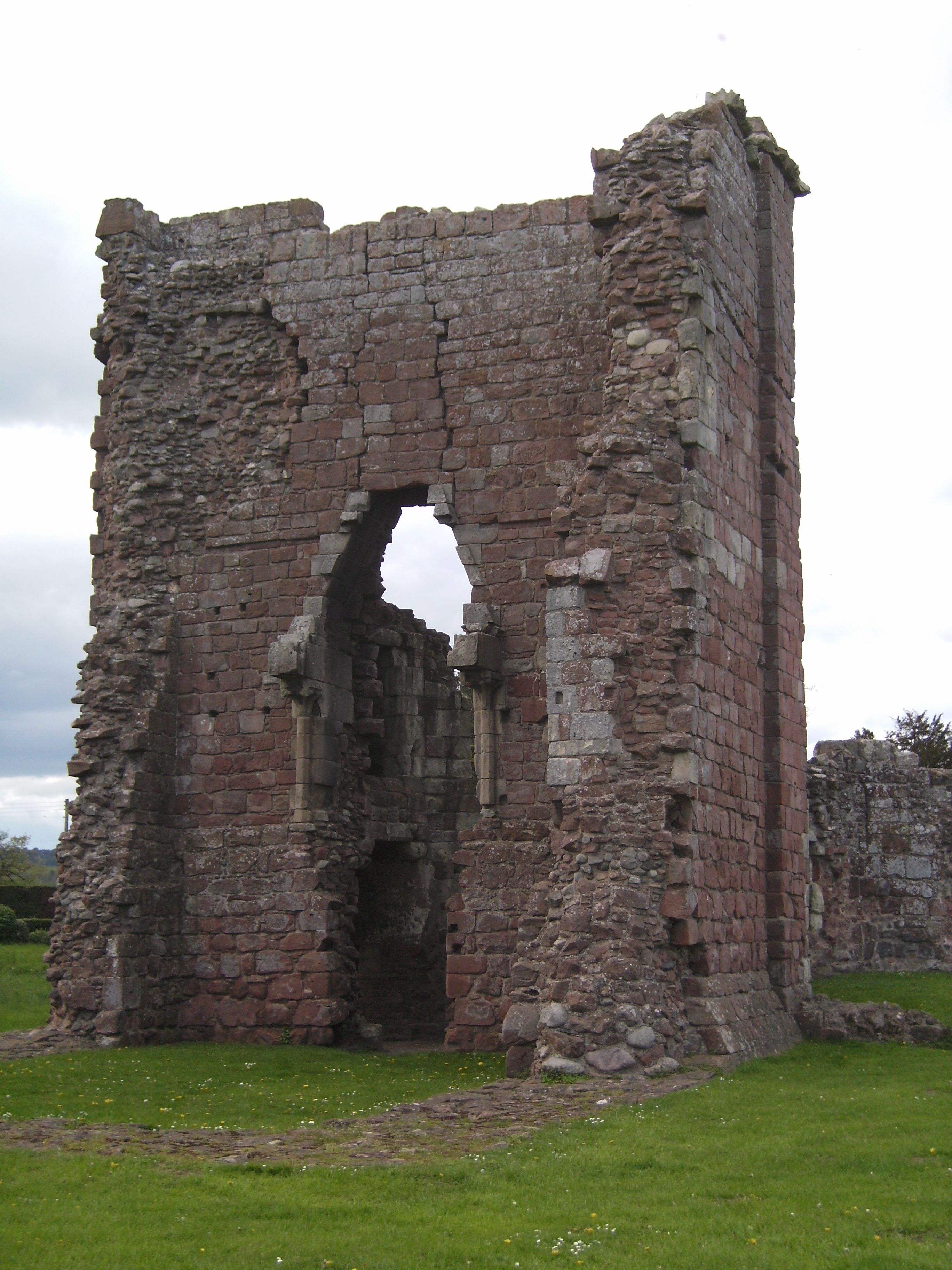Sir Robert Corbet and Elizabeth Vernon
Sir Robert Corbet was of Moreton Corbet, Shropshire, England and was born in 1477 to Sir Richard Corbet and Elizabeth Devereux. He inherited the estates of his grandmother, Elizabeth (Hopton) Corbet in 1499. Sir Robert married Elizabeth Vernon. Elizabeth was of Haddon, Derbyshire, England, the daughter of Sir Henry Vernon and Anne Talbot.
Sir Robert was knighted 17 November 1501, as part of the marriage of Arthur, Prince of Wales and Catherine of Aragon. He was the Sheriff of Shropshire in 1507. He held Commissions of the Peace in 1511 and 1512. In 1512, on a document entitled Appointments for War, Sir Robert Corbet appears on a list of "Names of lords and others with the number of men which they have granted, to serve the King's grace by land."
He died 11 April 1513. His will was written 23 April 1509 and proved 16 November 1513. In it, he left bequests to his eldest son, Roger, and to Elizabeth, making provisions for "every of my daughters, that is to say, Anne, Dorothy and Jane" and his sister Margaret. It is interesting to note that he seemed to have been especially focused on the state of his soul after death in this will. He left very detailed instructions related to his wishes for his funeral and the prayers and masses that would follow for two years after his burial, including a breakdown, by day of the week, of the masses to be said. In contrast, he only made one brief mention of his apparel, noting that it should "stand at my pleasure till my departing to give, do with and bequeath where I or my executors shall think most best and convenient."
Sir Robert would only have been about 36 years of age at the time of his death and his eldest son, a minor, went into wardship. Elizabeth survived Sir Robert by fifty years and died 29 March 1563. She was known as "the old Lady of Corbet in Shawbury." Sir Robert and Elizabeth are buried at St. Bartholomew Church, Moreton Corbet, Shropshire, England.
Sir Richard and Dorothy’s children are:
- Roger Corbet, knight, was of Moreton Corbet, Shropshire, England, mentioned in his father's will, was a minor at the time of his father's death and was the ward of Charles Brandon, Duke of Suffolk (brother-in-law of Henry VIII), then John de Vere, Earl of Oxford. The Earl's executors then sold the wardship to Andrew Windsor, Lord Windsor. Roger married Anne Windsor (dau. of Andrew Windsor, Lord Windsor, bur. at Lynceslade, Buckinghamshire, England in 1551, will written 22 Sep 1550 (4 Edward VI) and proved 8 Nov 1551), "obtained livery of his inheritance" on 22 Oct 1522, Member of Parliament for Truro, Cornwall, England (having owned land there) in 1529, Sheriff of Shropshire in 1529-30 and Nov 1538 to his death, Sheriff of Bedfordshire and Buckinghamshire in 1535-6, justice of the peace in Buckinghamshire in 1532, buried at Lynceslade, Buckinghamshire, England in 1538, will written 27 Nov 1538 and proved 1 Feb 1538/9, left black clothes for thirteen poor men and thirteen poor women, twelve months' wages to his servants (or his horses distributed among them, at Anne's discretion), and 30 gold rings marked RC to "speciall and trusty frends." He also left directions about his heir, giving insight into his experience as a ward and his fears for his eldest son Andrew: "I require and humbly beseke [beseach] my Suprvisors and my executrix, tenderly lamenting the captyve bondage of wardship, to consulte together, ponderyng the redyest wayes howe to redeme my herre out of the thraldom and bondage of wardship, for whose mariage I was offeryd one thousand marks."
- Richard Corbet, married Margaret Sayville (dau. of Sir John Savile of Thornhill, Yorkshire, England, widow of Thomas Wortley of Wortley, Yorkshire, England), granted wardship of his nephew Andrew Corbet (son of Roger and later Richard's heir) in 1539, "standard bearer in Henry VIII's last French war" in 1544, carver in the household of Prince Edward (later Edward VI), attended the funeral of Henry VIII in the entourage of Edward VI, resided at Wortley, Yorkshire and Poynton, Shropshire, England, Sheriff of Shropshire in 1561, Member of Parliament for Shropshire in 1558 and 1563, "one of the quenes majesties counsell in the Marches of Wales," died 17 Jul 1566 in Poynton, Shropshire, England, buried at Shawbury, Shropshire, England with a monument to him and Margaret at St. Bartholomew Church, Moreton Corbet, Shropshire, England in 1566, will dated 5 Oct 1564 and proved 20 Aug 1566. While he is said to have been a Protestant and the Sir Richard Corbet imprisoned in the Tower of London after the fall of Lady Jane Grey, The History of Parliament calls into question the accuracy of these statements.
- Reginald Corbet, was of Stoke upon Tern, Shropshire, England, educated at the Middle Temple (Inns of Court), married Alice Gratewood (dau. of John and Jane (Hill) Gratewood of Wollerton, Shropshire, England, niece of the first Protestant Lord Mayor of London (Sir Rowland Hill), d. 9 Apr 1603, called "my singular good wife Alice" by Reginald in his will) 23 Aug 1546 in Hodnet, Shropshire, England, Lent reader at the Middle Temple in 1552, auditor in 1556, assistant to the reader in 1559, Member of Parliament for Much Wenlock, Shropshire, England in 1542 and for Shrewsbury, Shropshire, England in 1547, Oct 1553, and 1555, Feodary in Shropshire in 1543, recorder in Shrewsbury in 1547-27 Dec 1559; commissioner (of chantries in Shropshire in 1547, relief in 1550, subsidy in 1563), justice of the peace in Shropshire in 1547, member of the council in the marches of Wales in 1553; justice of Anglesey, Caernarfonshire, and Merioneth, Wales 6 Apr 1558 to his death, serjeant-at-law Apr 1559; Justice of the the Queen's Bench, died 19 Nov 1566, buried with Alice at St. Peter Church, Stoke upon Tern, Shropshire, England, will written 26 Aug 1565 and proved 22 Jan 1566/7. In his will, he took care to forgive and ask forgiveness from all men and ask forgiveness from God (having forgiven all men that had offended him). He then left bequests to the children of "my old master my brother Roger Corbet" and other family members and provided for his servants (one year's wages and lodging, until otherwise provided).
- Anne Corbet, mentioned in her father's will, married Sir Thomas Newport.
- Dorothy Corbet, mentioned in her father's will, married Sir Richard Mainwaring (born in or before 1497, of Ightfield, Shropshire, England, the son of Sir John and Joan (Lacon) Mainwaring, Commissioner of Peace in May 1538, Sheriff of Shropshire in 1544 and etc., among the knights who welcomed Anne of Cleves to England, died 30 Sep 1558 in St. Albans, Hertfordshire, England, buried 7 Oct 1558 in Ightfield, Shropshire, England.
- Jane Corbet, mentioned in her father's will, married Thomas Lee (knight, of Langley, Shropshire, England, will written 28 May 1561 and probated 24 Jan 1562/3).
- Mary Corbet, mentioned in her brother Roger's will, married Thomas Powell (of Oswaldestre (Oswestry, Shropshire, England)). Maria was the only daughter not mentioned in her father's will (the younger sons Richard and Reginald were not mentioned) but she appears in an inquisition post mortem and Sir Robert and Elizabeth's tomb depicts four daughters. As Sir Robert was only about 32 at the time of his will and about 36 at his death, one possible explanation is that Maria was before after the will and before the inquisition post mortem.
Note: Anne was called Joanna by Boyer and Johanna or Anna by Augusta Corbet but original sources call her Anne or Anna (Latin form of Anne). Joanna is another form of Jane, as is Johanna. Sir Robert and Elizabeth's daughters were certainly Anne (or Anna), Dorothy (or Dorotte), Jane (or Joanna), and Mary (or Maria).
Sources:
Records related to Sir Robert and Elizabeth (Vernon) Corbet but not copied below due to copyright considerations:
- Tombs of Sir Robert and Elizabeth (Vernon) Corbet and Richard and Margaret (Sayville) Corbet, St. Bartholomew Church, Moreton Corbet, Shropshire, England.
- Tomb of Reginald and Alice (Gratewood) Corbet, St. Peter Church, Stoke upon Tern, Shropshire, England.
- Corbet, Augusta Elizabeth Brickdale, The Family of Corbet: Its Life and Times, London: The St. Catherine Press, 1914, pgs. 262-71. This book is available at Archive.org
- J. S. Brewer (editor) (1920). "Henry VIII: February 1514, 1–10". Letters and Papers, Foreign and Domestic, Henry VIII, Volume 1: 1509–1514. Institute of Historical Research. http://www.british-history.ac.uk/letters-papers-hen8/vol1/pp1147-1153, retrieved 1 August 2013.
- James Gairdner and R. H. Brodie (editors) (1894). "Letters and Papers: July 1539, 26-31". Letters and Papers, Foreign and Domestic, Henry VIII, Volume 14 Part 1: January–July 1539. Institute of Historical Research. http://www.british-history.ac.uk/letters-papers-hen8/vol14/no1/pp574-593, retrieved 4 August 2013.
- Nicolas, Sir Nicholas Harris, History of the Orders of Knighthood of the British Empire; of the Order of the Guelphs of Hanover; and of the Medals, Clasps, and Crosses, Conferred for Naval and Military Services, Vol. 3, London: John Hunter, 1842, p. xi. This book is available at Google Books.
- Boyer, Carl, Medieval English Ancestors of Robert Abell, Santa Clarita, CA: C. Boyer, 2001.
- Will of Sir Robert Corbett or Corbet, The National Archives of the UK (TNA): PROB 11/17/471.
- Will of Richard Corbett of Wortley, Yorkshire, The National Archives of the UK (TNA): PROB 11/48/556.
- Will of Roger Corbett, The National Archives of the UK (TNA): PROB 11/27/408.
- Short title: Lord Windsor v Wingfylde. Plaintiffs: William WYNDESOR, lord Windsor, and others, executors of Andrew, lord Windsor. Defendants: Robert WINGFYLDE, esquire, executor of Humphrey Wingfilde, knight, an executor of John [de Vere], earl of Oxford. Subject: Action on a bond for price of the wardship of Roger Corbett, long since paid., The National Archives of the UK (TNA): C 1/1485/58.
- Will of Reginald Corbett, one of the Queens Her Justices of Her Plees of Moreton Corbet, Shropshire, The National Archives of the UK (TNA): PROB 11/49/18.
- Will of Anne Corbet, Widow of Linchlade, Buckinghamshire, The National Archives of the UK (TNA): PROB 11/34/443.
- Will of Thomas Lee of Langley, Shropshire, The National Archives of the UK (TNA): PROB 11/46/40.
- Entry for CORBET, Reginald (by 1513-66), of Fitz and Adderley, Salop; Stoke-upon-Tern, Staffs., The History of Parliament, http://www.historyofparliamentonline.org/volume/1509-1558/member/corbet-reginald-1513-66, retrieved 17 Jul 2017, originally published in The History of Parliament: the House of Commons 1509-1558, ed. S.T. Bindoff, 1982.
- Entry for CORBET, Richard (by 1512-66), of Wortley, Yorks. and Poynton, Salop., The History of Parliament, http://www.historyofparliamentonline.org/volume/1509-1558/member/corbet-richard-1512-66, retrieved 17 Jul 2017, originally published in The History of Parliament: the House of Commons 1509-1558, ed. S.T. Bindoff, 1982.
- Entry for CORBET, Roger (1501/2-38), of Moreton Corbet, Salop; Linslade, Bucks. and London., The History of Parliament, http://www.historyofparliamentonline.org/volume/1509-1558/member/corbet-roger-15012-38, retrieved 17 Jul 2017, originally published in The History of Parliament: the House of Commons 1509-1558, ed. S.T. Bindoff, 1982.
Photos and Images
Tomb of Sir Robert and Elizabeth (Vernon) Corbet, St. Bartholomew Church, Moreton Corbet, Shropshire, England (photo credit: (all but last photo of the couple's tomb) Sjwells53, Wikipedia; (last photo) Douglas Micah Vail, findagrave.com):
Above are the figures of the Corbets' four daughters and an angel on the western end of the tomb.
Tomb of Richard and Margaret (Sayville) Corbet, St. Bartholomew Church, Moreton Corbet, Shropshire, England (photo credit: Sjwells53, Wikipedia):
Tomb of Reginald and Alice (Gratewood) Corbet, St. Peter Church, Stoke upon Tern, Shropshire, England (photo credit: Jean McCreanor and by Dr John Davis, Church Monuments Society):
For another view of the tomb, see the Flickr site for jmc4 - Church Explorer
Ruins of Moreton Corbet Castle, Moreton Corbet Shropshire, England (photo credit: Sjwells53, Wikipedia)
For the English Heritage site for Moreton Corbet, go to http://www.english-heritage.org.uk/visit/places/moreton-corbet-castle/
View of the medieval castle with the Elizabethan house behind:
Gatehouse:
Interior of the gatehouse:
Courtyard of the castle, church in the background:
Keep (used as residence in the medieval and early Tudor eras):
Corbet Arms:
From Augusta Corbet's The Family of Corbet
Elizabeth Hopton lived till 1499, and at her death her estates were duly inherited by her grandson Robert Corbet, the account of whose life we are just about to piece together. I take him to have been nearly 22 years of age at the time of his grandmother's death, and his inheritance of all her lands and dowers.
Sir Robert married Elizabeth Vernon, daughter of Sir Henry Vernon. A very interesting portrait of her painted on a panel exists at Acton-Reynold -the present inhabited seat of the Corbets of Moreton-Corbet. — It is remarkable, too, as being the oldest in date of the many portraits of our Ancestors and Ancestresses which line the walls there. Sir Robert, her husband, filled the position of head of the Family for just ten years. We find his name is seventh in a list of fifty-seven knights of the Bath who were knighted at the marriage of Prince Arthur. Blakeway in his Sheriffs of Shropshire states that Sir Robert was Sheriff in 1507 ; the Pedigree gives the date as 1501.
There are one or two references to his name in the Letters and Papers of Henry VIII. 's reign. Thus we read : 14 Feb. 1510 P.S. " For Thomas Kynastone of Lee, late Sheriff of Salop. Pardon and release ; also release to Sir Robert Corbet of Morton, Salop, and Roger Thornes of Shrewsbury, of their recognition of £40 made 30th Oct: 23, Hen: VII. 14 Feb: Pat: i Hen: VIII etc:".
Sir Robert held Commissions of the Peace both in this year 1511 and in the following year, and in 1512 his name is among the " Appointments for War." " Names of lords and others with the number of men which they have granted, to serve the King's grace by land, viz. : The Duke of Buckingham, Earl of Shrewsbury, Lord Fitz-Warren, Sir Thomas Lovel, Sir Robert Corbet etc. . . ." The Commissions of Peace for Feb. 1513 contain Sir Robert's name, but an entry of 10th Jan. and again of 30th Jan. tells of his decease. The entry runs : " For Chas: Brandon Viscount Lisle. Wardship of Roger son and heir of Sir Robert Corbet." "Richmond 5 Hen. VIII." Dodsworth also records from the Escheat for the Essex lands on Sir Robert's death, 5, Hen. VIII. No. 87, that " Robert Corbet held the Manor of Woodham Mortimer and the Manor of Welbrigge-hall, and died on the iith April 4, Hen. VIII. and Roger Corbet is his son and heir and of the age of 12 years." A Reference also among the Harrison Indexes gives " Inq: P.M. of Sir Robert Corbet knt, taken at Salop 16, June 5, Hen. VIII. Sir Robert Corbet died 11th April 5, Hen: VIII, leaving a widow Elizabeth, and children Roger (aged 11) Anna, Dorothy, Joanna, and Maria." A Deed which is almost in the form of a will is also recorded in Dods. MSS. It bears no date but " was proved in Nov: 1513." " Whereas I Sir Robert Corbet, knight, have made by Deed unto Sir Henry Vernon, knight, Thomas Inglefield, knight, Thomas Cornewale, knight, Thomas Laken Esqr:, Roger Corbet my son and heir apparent Esquire, Richard Vernon Esquire, etc: all my lordships and lands in Hopton, Fitz, Eton, Constantine, Lawley, Water Upton, Dalyngton, Lynchlade, Sothcote, Howbrighill, and Wyggynton, in the Counties of Salop, Northampton, Bucks, Essex, and Hertford, to hold for the use of me the said Sir Robert Corbet and my heires. Item I bequeth my bodye to be buryed in the Church of St Bartilmew att Moreton-Corbet, Elizabeth, the Testator's wief, Roger Testator's son and heire, Anne, Dorotte, and Jane the Testator's daughters, each C marks. Proved 15 Nov: 15 13."
The date shows us how steadily the years are creeping onwards, and, with them, life with its changing habits is rapidly assuming the mould out of which springs our complex life of to-day, to be fashioned according to the exigencies of the passing moment. Very shortly too we shall have reached the time when the Parish Registers will open their pages to the seeker who would learn
from these treasured and faded characters, of the love, the joy, the tragedy of many a past and forgotten life ; hitherto so jealously guarded from the public gaze. Wills also begin to be more often made, and are more easily available. I have mentioned the Deed which Sir Robert executed for the disposing of his property ; and I will add here some extracts from the Will itself which confirm the wishes expressed in the Deed. Indeed, all relating to Sir Robert's personality is peculiarly interesting, if only from the fact of his fine tomb, which is in the Church at Moreton-Corbet and which, so to speak, fixes him irresistibly in our memory.
" In the name of GOD ... I Sir Robert Corbett knyght have made a feoffement by dede unto Sir Henry Vernon, knyght, Thomas Englefelde, knyght, Thomas Cornewaile, knyght, Thomas Laken, Esquyer, Roger Corbet, my sonne and heire apparaunt, Esquyer, Richard Vernon Esquyer, Roger Thornes, Esquyer, and George Onneslowe of all my lordshippes, maners, mess:, landes, and tenements, and all other hereditaments with thapptunces in Hopton, Ffytts, Gwn Gonstantine, Lawley, Waterupton, Dalyngton, Lynchelade, Sothcote, Howbrighill, and Wyggyngton, within the Counties of Salop, Northampton, Bukynghm, Essex, and Hertford, to have and to hold to them their heires and assignes to the vse of me the foresaid Robt. and of myn heires to fulfil my last will ....
" To be buried in the Churche of Seynte Barthilmewe at Morton Corbet.
" My Executors to provide ij honest prests to syng and saye masses and other devoute prayers by the space of ij hole yeres . . . and evdy" (every) "of the said prests to have viij marcks for their hire.
" To Roger, my sonne and heir, my best salt, my best pece of sylvr, my best goblet and half my spones. And all the Residue of my said plate to Elizabeth my wyff, duryng her lyff and afere her decese to remayne to Roger my said sonne.
" To evdy of my Daughters, that is to say, Anne, Dorothe, and Jane the some of C mks for their marriage.
" My Executors to paye for the mariage of Margaret my suster the some of XI marks.
" My said feoffes to make an estate of all the said lordshipes, maners, mess: lands etc: vnto Roger Corbet my sonne and heire And to the heires of his body lawfully begotten. And for lake of suche Issue to my Right heires.
" Executors Thomas Cornewaile knyght, Thomas Laken Esquyer Elizabeth my wyff, George Bromley and George Onneslowe. Overseers. Henry Vernon knyght and Richard Vernon his Sonne and heire.
" Dated XXiij April 1509.
" No witnesses.
" Proved xvi Nov: 1513 by Elizabeth the relict."
The " Suster Margaret " for whose marriage he leaves directions married Sir Richard Clyve of Walford ; and we may note that he leaves his affairs entirely in the hands of near relations — father-in-law and brothers-in-law, etc. His daughters all married subsequently, Jane became the wife of Thomas Lee, of Langley, Co. Salop ; Johanna or Anna married Thomas Newport ; Maria was the wife of Thos. Powell, of Oswaldestre ; and Dorothea married Richard Mainwaring, of Ightfield. At this time the wealth and influence of the Family must have been very considerable, and indeed continued, as we may say, at its zenith till once again the Family were impoverished by the surrendering of Manors by the hands-full, so as to satisfy the claims of certain heiresses; and this again to be shortly followed by the confiscations of those who called themselves the liberal rulers of their country !
Sir Robert Corbet was buried in the Church of St. Bartholomew at Moreton-Corbet, and among his ancestors, as he desired. A striking altar tomb was erected to his memory and to his wife's, Elizabeth Vernon. It attracts the eye immediately as one enters the interesting little Church and is worth describing. The tomb is in the Corbet aisle, or Chapel, which, as we recorded in an earlier chapter, was built in the reign of Edward III. by the Sir Robert Corbet of that day. The description of the tomb is to be found in the Transactions of the County Archeological Society. The inscription which is in Latin, states that Sir Robert is here buried and Elizabeth his wife ; the which Robert died 11th April, 1513, and Elizabeth on the 29th March 1563. Below the ledge bearing the inscription, on either side and at the ends, is a lozenge sable, with a squirrel sejant or. At the west end is a civilian as a weeper, bearing a shield of arms emblazoned : and on his right and left hands are figures of winged angels. The same arrangement of weepers bearing shields with coats of arms, supported by winged angels, is repeated on the south side. At the east end appears a monk in brown dress and a winged angel on either side, in the right hand of one of these is a black cross. The whole is very highly coloured and ornamented. Figures of children stand round the sides of the tomb. The two effigies, life size, which lie on the top are of Sir Robert and his Lady. The former is in plate armour with an apron of mail, the head lies supported on his helmet with its crest — (in place, and rather unusually large) of the Raven — a dagger is on his right side and a sword on his left. The feet rest on a lion. The Lady's head rests on a cushion borne by angels, and a dog lies at her feet : she wears a wreathed head-dress and her dress is the rather stiff costume of Queen Mary's reign. She outlived her husband many years. I find her death is recorded as occurring in 1563. Her father was Sir Henry Vernon, a man of note and esteem. We read of him as at one time Governor to the young Prince Arthur. He it was who rebuilt the Church at Tong and endowed it with the big Bell leaving a special rent charge on his Manor at Norton " for the tolling of it, when any Vernon comes to town." All this, however, came to an end in time, for Cromwell ordered the bell to be destroyed, as was to be expected of him.
There is a beautiful monument in Tong Church to Sir Henry Vernon and his wife, who was Anne Talbot, a daughter of the Earl of Shrewsbury. Sir Henry's son Richard, who succeeded him, is also mentioned in the Will from which we have quoted. I think it will be interesting too to record that it was this son Richard's grand-daughter (Dorothy) who was the heroine of the romantic elopement with Sir John Manners in after years. Dorothy was therefore great-niece to our Elizabeth Vernon. The scene of the elopement was Haddon Hall, where Sir Richard, Dorothy's father, had mostly resided.
Sir Robert Corbet had three sons. Roger the eldest we have already heard of in his Will. He was about twelve years of age at his father's death, and was placed under the Guardianship of Sir Charles Brandon, later the Duke of Suffolk. Richard was the name of the second son ; Reginald, or, as more often spelt, Reignold and Reynold, the name of the third. The latter distinguished himself at the Bar, and founded also the important sub-branch of Stoke and Adderley. To accord this important sub-branch the lengthened history it demands here would, I feel, cause too great an interruption in the main current of my story ; I will therefore defer doing so till the space and leisure afforded by the last chapter, or, maybe, one of the last in this Volume.
The record of Richard, the second son, is, however, more swiftly given and ended, though he played no mean part in life. Let me, then, give his record here, and then consider the fortunes of the elder brother Roger. The inscription on the altar tomb which is also in the little Church of Moreton-Corbet styles this second son " armiger " ; there seem, nevertheless, to exist certain indications that he may have been knighted at some period or other of his life, sufficient to warrant our looking into them. A Sir Richard Corbet is mentioned among those knighted on an occasion in France which I will presently describe, and I note that the ceremony was performed by Sir Charles Brandon, afterwards the Duke of Suffolk ; he was then Viscount Lisle and had been Guardian to the elder brother Roger Corbet, who had recently attained his majority. The doubt is whether the knight referred to be our Richard, the second son of Sir Robert of Moreton-Corbet, or another Sir Richard who was also undoubtedly knighted, and before 1525, at which date this latter died. The date of the ceremony in France is 1523. Let us see to the probabilities. I think they appear stronger in favour of the other Sir Richard, who dates his will 1525 and styles himself therein, " Sir Richard Corbet knight." He was of Assington, Suffolk ; almost the last member of the ancient Branch of the Corbets of Tasley, etc., whom I can identify. On the other hand, both Roger and his brother Richard appear to have sympathised with the Reformed Religion, and at the Coronation of Anne Boleyne a Corbet, whose name is not found, appears to have been knighted.
Richard Corbet's adhesion to the fortunes of the Reformed Faith is manifest from his position in the Household of the young King Edward ; but on Queen Mary's accession these very opinions, coupled with his supporting the claim of the unfortunate Lady Jane Grey to the Throne, landed him as a prisoner in the Tower ; and pardon was refused him. It was during this imprisonment that the strongest bit of evidence occurs in favour of his having been knighted. It is in the shape of a letter to the Lieutenant of the Tower (1st Mary) from the Privy Council giving certain instructions concerning his prisoner " Sir Richard Corbet."
It is no great matter which way the truth lies. A few words, however, concerning the other Sir Richard, he who died in 1525, will be of interest. This Sir Richard was one of the last of a long line of ancestors who had held their lands in Shropshire, Staffordshire, and Suffolk, for almost as many centuries as the Corbets of Moreton-Corbet themselves. He was then the representative (but illegitimate) of the Corbets of Tasley, King's-Bromley, etc. Their history is given at length in Volume I. Their chief residence had been for some time at Assington in Suffolk, for King's Bromley was sold and Tasley had been parted with much earlier. This long line ended in illegitimacy through an illegal marriage —the grandmother of the Sir Richard of whom we write — she remarried after her Corbet husband's death, and, having a very powerful ecclesiastical influence in the person of her second husband, she was allowed possession of the Corbet properties in Suffolk, Norfolk and Shropshire, though she had no shadow of title to them, and the real legal heir, her brother-in-law Roger Corbet, after suffering imprisonment, died soon after his release therefrom, and without heir. This Sir Richard left an infant son (Richard) at his death of only a few months old, who was given to the Guardianship of Sir Humphrey Wingfield, of a well known family in Shropshire and Suffolk, and whose family in later years had many dealings with our Corbets ; indeed, his ward's lands lay close on the borders of Moreton-Corbet, and I believe that in after years High Hatton did become annexed to the Moreton-Corbet estates, though now sold. However that may be, it appears that on attaining his majority the young Richard sold Assington, etc., to one named Gundon, and we do not hear further of him.
The account of the knighting in France is as follows : " Nov: 7. 1523 The Army in France." " In the 15th yere of the reigne of our soverayne lorde Kyng Henry the Eight, the actes done in France under the honorable the duke of Suffolk."
" 31 Oct: camped on the south side of Roye, 1 Nov: my Lord removed to the north side of Roye, and there made 14 knights, lord Powes, lord Harberd, Sir Arter Pole, ... Sir Richard Corbett,"
etc.
This extract is from the Collections of the Letters and Papers foreign and domestic of the reign of Henry VIII. More knights they tell us were created at the Coronation of Queen Anne Boleyn, and these papers give the name Corbet amongst those chosen, but no distinctive name. Here then again is an occasion either for the knighting of Richard, the second son (if he were ever knighted), or of the elder brother Roger. They must have been near of an age.
The Add. MS. is quoted again : "Coronation of Anne Boleyne. The appointment of what number of officers and servitors attend upon the Queen's grace, the Bishop and the ladies sitting at the Queen's board in the Great Hall at Westminster, the day of the Coronation, as followeth." Knights of the Bath. "Marquis of Dorset, Earl of Derby, lords Clifford, Fitzwater, Hastings, Montegle, and Vaux, . . . Mr. Corbet, Mr. Wyndham." In another extract from the Letters we have : Coronation of Anne Boleyne . . . Friday, 29th May, " the following gentlemen, who were appointed to be knights of the Bath, served the King at dinner, and were bathed and shriven according to custom ; the next day they were dubbed."
Richard Corbet married Margaret daughter of Sir John Saville knight, and widow of Thomas Wortley Esqr. of Wortley. In 1538 he is mentioned in the Books of the Court of Augmentation as being granted a Lease, 29 Hen. VIII. " Richard Corbett of the Household. Stone Rectory Staff." The next entry in the " Letters and Papers " of this reign is in 1539, at which date his brother Roger had died and the heir (" Andrew ") became his ward. The entry says : " Grants in July 1539 " " Richard Corbet. Annuity of £40 out of the issues of the Manors of Morton-Corbet, Shawbury, and Hopton, Salop, which belonged to Rog: Corbet deceased, during the minority of And: Corbet, son and heir of the said Roger, with the wardship and marriage of the said Andrew."
Richard Corbet was Sheriff for Shropshire in 1561. He lived till 1566 and his death is quaintly recorded in the old Shrewsbury Chronicle. "This yeare " (1566) " dyed Mr. Rychard Corbett, sonn to Sir Robert Corbett, of Morton-Corbet, knight. He was karver to Prynce Edwarde, standart-berar to his bannde at Bullen, and one of the quenes majesties counsell in the Marches of Wales ; and lyeth buryed in the weast syde of Shaberies Churche, 5 myles from Shrewsbury, and dyed w'out yssue."
The entry from the Books of the Privy Council referring to his imprisonment in the Tower is as follows : " Sept: 10th primo Mariae " "A letter to the Lieutenant of the Towre whereby he is willed to permit these ladies followinge to have access to their husbands." Four are named, and the letter proceeds, " and Sir Richard Corbet's wife." As we know, she was the daughter of Sir John Saville, and widow of Thomas Wortley of Wortley. "Carte," who gives the record in his papers, adds, " But I see no proof that he " (Richard Corbet) " ever received the honour of knighthood, and I cannot satisfy myself who Sir Richard was." There is no indication of the length of his imprisonment ; we find him, however, in favour with Queen Elizabeth and he was made Sheriff for Shropshire in 1561. His nephew and ward Sir Andrew was first made Sheriff in Edward VI. 's reign in 1551.
It seems perhaps strange that Richard the uncle should have imperilled his position by furthering the claims of the unfortunate Lady Jane Grey, since it is evident that his nephew Sir Andrew was no partaker in the intrigue ; possibly the uncle found himself drawn into it through the old intimacy with the Duke of Suffolk and his known leanings to the reformed religion. He lived till 1566.
The following Deed is from the " Evidences of Sir Francis Wortley 13 March 1637," and given by Dodsworth in his MSS. " I Richard Corbet of Wortley esquire, second son of Robert Corbet of Moreton-Corbett Co. Salop, knight, have given to Richard Clyve of Huxley, Co Chester, esquire, and Ralph Clyve of Walford, C, Salop, esquire, all those my two manors of Carleton and Swinton, with appurtenances in the County of York, and all my messuages, lands, etc: in Adwyk-super-Deorne, Barnburgh, Bernolthorp, Harlington, Cadeby, Canonthorp, Tynneslow, Ruston, Monk-bretton, or elsewhere in the County of York. To hold to the said Richard and Ralp, to the use of me, the aforesaid Richard Corbet and Margaret my wife, and the heirs of the body of me, the aforesaid Richard, to remain to the behoof and use of Francis Wortley, and the heirs male of his body etc: Dated 4 February, 8 Elizabeth." Also " Precipe to Anne Fairfax, wife of Thomas Fairfax, esquire, that she justly hold to Richard Corbet, esquire, the convention etc: concerning the Manor and lordship of Swinton, with 6 tofts, 30 acres of arable land, 3 acres of meadow, 8 acres of wood, and 100 acres of common, with appurtenances, in Swinton. And the agreement is such that the said Anne acknowledged the aforesaid Manor, with appurtenances, to be the right of the said Richard and his heirs."
Richard Corbet was in Shropshire, I believe, at the time of his death. He held some property in a hamlet called Paynton, or Poynton, and was buried in Shawbury Church, where was the tomb now to be seen in the Church at Moreton-Corbet. It was removed thither at the time of some alterations in the Church at Shawbury and placed in its present position in that of Moreton-Corbet. The tomb is thus described in the Archaeological Transactions to which we have already alluded. "At the West End," says the quotation, "is another altar tomb with effigies of a man and woman. The man has a peaked beard, the head rests on a helmet with the sable Raven as crest. He is in plate armour with an apron of mail ; the neck frilled — the feet rest on a lion and are spurred. He has gauntlets and dagger on his left side, no sword, and his wrists are frilled. The figure of the wife has a wreathed head-dress with long top peak bent back under the head, which rests on two cushions, she wears a frilled black embroidered gown with pomander in front and has a ruff. Below the shields are an Elephant and Castle, and an owl. The inscription round the verge is in Latin and states that Richard Corbet, armiger, was the second son of Sir Robert Corbet, knight, — that he died in July 1566 — that he married Margaret the daughter of Sir John Saville of Thornhill, Co. York ; and that she was the widow of Thomas Wortley, armiger, of Wortley, Co. York."
With this ends my record of Richard Corbet, the second son of Sir Robert Corbet, knight, of Moreton-Corbet.
Of the eldest son, Roger, who succeeded his father, we have yet to write. The terms Esquire and Armiger were becoming so generally accepted as the sign-manual of gentle birth, that we shall find many fewer knights among the sons of the Family than heretofore. There seem but few records to note of this eldest son Roger ; he had the livery of his lands, in other words he came of age, about 1522. We find his name on some of the Commissions of the Peace and his name is on the Sheriff Roll for Shropshire as early as 1529 and pricked by the King. In the year 1535-6 his name appears in the list of Commissioners for Shropshire appointed to verify a Grant of " Tenths of Spiritualities " ; his fellow Commissioners were Sir Thos. Cornewayle, Sir Wm. Thomas, Roger Corbett, Thos. Newport, Robt. Needham, — John Corbet of Lee. The Lincolnshire rebellion was brought to a close in the October of this same year : seventy-seven " Letters Missive " under the privy signet were sent out to the under-mentioned persons, countermanding a late Order already addressed to each of them by similar " Letters," and which latter had ordered them to be at Ampthill by " Monday next, so as to attend the King in his expedition, to put down the rebels in Lincolnshire, as these have been already overthrown by the King's loyal subjects in those parts." The persons addressed were, " The Abbot of Abyngdon, Sir Gyles Alyngton, John Amidas, Thos: Chichely, Rog: Corbet, Sir Thos: Cornewayle." Roger Corbet married Anne, a daughter of Andrew Lord Windsor. He had many children and died at his estate at Lyncheslade in Buckinghamshire, in 1538-9.
Among the many changes of this date, we may note the introduction of new names in the Family. Roger Corbet's eldest son was christened "Andrew," evidently so called after his maternal grandfather, Andrew Lord Windsor ! The reign of Henry VIII. was truly a most unenviable and dangerous time in which to have lived, even though the daily strifes of the Wars of the Roses were ended ! It must have been a time of such unrest, and diversity of opinions and beliefs, that men can scarce have realised what it was they truly did believe, or were ordered to believe ; and I think our Ancestors of that time must have daily given thanks to the Almighty, as morning broke, and they found their heads still resting firmly on their shoulders, while they perceived now this neighbour, now that, imprisoned and even executed for one scarce knew what. Increasing violence was the tenor of these last days of King Henry's reign. Superstition under these conditions of uncertainty both temporal and spiritual would assuredly flourish. It was but a few years after Roger Corbet's year of Shrievalty that the following entry occurs in one of the Town Corporation Books of Shrewsbury. It commemorates no doubt an unusually heavy and destructive storm of thunder and lightning, but by the townsfolk of that day it was interpreted as follows : — " This yeare 1533 upon twelffth daye in Shrousberie, the dyvyl appeared in St Alkmund's Church, there when the Priest was at highe Masse with grate tempeste and darknesse, that as he passed throughe the Churche he mounted uppe the steeple in the sayde Churche teringe the wyer of the sayde Churche, and putte the prynte of his clawes uppon the IIjth bell and toocke one of the pynnacles awaye with hym and for the tyme stayed all the bells in the churches, so that in the sayde Towne they coulde neyther tolle nor rynge."
The smaller Religious Houses were all suppressed a year or so later, and by the year after Roger Corbet's death in 1539 all the more important ones also had shared the same fate. Many penalties were exacted from those who still persevered in their exhibitions of sacred relics, so called, and their frauds were relentlessly exposed. The Reformed Religion gained strength, though of a truth it suffered much opposition and hindrance both from friend and foe. London hailed her first Protestant Lord Mayor in 1540. This was the first Sir Rowland Hill, and his memory is so closely connected with the founding of the sub-branch of the Corbets of Stoke and Adderley, that we must make good note of his personality as well as of Roger Corbet's youngest brother Reginald, with whom the famous Lord Mayor was so nearly connected. Sir Rowland Hill, we may note in passing, made the road between London and Kilburn : a boon we do not doubt to all travellers. Drayton owes her Free School to him, and in 1549 he rebuilt and restored nearly the whole of the interesting Church at Stoke-on-Tern. His nephew-in-law was Reginald Corbet, the third son of the late Sir Robert Corbet of Moreton-Corbet. This younger son chose the Law as his career. His wife was Alice Gratewood, the daughter of one of the heiresses of the wealthy Lord Mayor to whose beneficent works we have just alluded. They were married at Hodnet in the August of 1546. Thus was founded the important sub-branch of the Corbet Family at Stoke and Adderley. Reginald made his own mark in his County, of which we have one or two traces. The Corporation of Shrewsbury has preserved a letter from him and very shortly after its date we find him Recorder of the Town. The letter is as follows : — " Emanuel, Right Worshipful! Master Bayliffs after moste hartist commendacons to you this is to asserten you that I have sent you downe here enclosed yor demurrars in law sent unto me, having two which I stey as yet in the discusse thereof. Also yor' Wrytte of Corpus cum causa, which I could not returne in yor' names except I had the record whereby they were arrested with you, which you sent me not. I have declared my mynde what I thyncke not the law in the demurrars. In the rest of yor' matters I intend GOD blesing to talke with you thereof this lent tyme, and thus I committe you to GOD.
"Ffrom Camb: xix daye of February 1548 by yor' assured."
"signed"
A few years previously, at the time of the suppression of the Monasteries, he and some like-minded friends tried to gain the Royal assent to a scheme for appropriating some of the lands and monies of the ancient Abbey and Monastery of Shrewsbury towards the foundation of a Free School. The scheme did not find favour, unluckily, though indeed what could have been a more fitting destiny for an Institution which through so many centuries had served as a power for good in the land ; or a more happy achievement for the descendant of one of the first of that Institution's Founders and Benefactors ! Henry VIII., however, would listen to no such proposition ; notwithstanding, the plan for the founding of a Free School found supporters later and the scheme for one was finally realised. An entry in the Town accounts for 1548 records " Paid Reginald Corbet, the Recorder for a supplication exhibited to the Lord Chancellor to obtain a free school 10s " " Given to a servant of the Lord Chancellor for his favour in the same 20d." The Chancellor was Lord Rich.
Our Recorder soon rose in importance, and in 1559 he was a Judge of the Queen's Bench. At that date he had already been married many years ; his wife was Alice Gratewood, the marriage took place at Hodnet in the August of 1546. Alice Gratewood was the niece of the famous Sir Rowland Hill, the first Protestant Lord Mayor of London. As this latter had no children nor brothers, his two sisters and their descendants finally inherited the greater part of the Lord Mayor's vast wealth and estates. These two sisters, Elizabeth and Margaret, married, the former John Barker, and the latter (Margaret) John Gratewood of Wollerton, Co. Salop. Our interest for the moment lies with the Gratewoods, as eventually Alice inherited all her mother's share of the property. As we have stated, she married Reginald Corbet and thus brought a large property and influence into the Corbet Family at Stoke and Adderley.
The fortunes of the much desired school were not neglected, though some years elapsed before the real steps for its establishment could be taken. A short entry in the accounts of the Corporation of Shrewsbury alludes to the accomplishment of the project and records : " Paid for the purchasing
of a free school to be had within the Town £20." The foundation was established by Royal Grant, and Blakeway considers that this last sum of money was probably a part of the consideration paid for the estates settled upon the School by Edward VI.
Reginald the Judge lived, latterly at any rate, at Stoke-upon-Tern, where what is now a farmhouse is still spoken of as his residence. It bears evidences of the moat which once surrounded it and of sundry buildings which are now pulled down. A bridge over the little stream of the Roden is also said to have been built by him.
He and his wife Alice are both buried in the Corbet Chapel of the Church at Stoke ; a very fine altar tomb covers the spot : it is in alabaster and said to be one of the finest specimens of its kind. Sir Reginald's effigy shews him dressed in the Judge's robes of the day, the support for the head has disappeared but the attendant Raven is still there. His wife Alice, who survived him some years, is clothed in very handsome garments : they had a large family and these, after the manner of the day, are commemorated on the tomb, the boys ranged on one side of its walls, the daughters on the other. Their eldest son " Rowland " died as a boy and was buried at Drayton, where he was one of the first scholars in the fine school provided by the munificence of his grand-uncle the Lord Mayor. Reginald Corbet is recorded in the entry of burial for his son, in the Parish Register, as of Cotton in the Parish of " Stock." He put up a brass to his son's memory in the Parish Church of Drayton which bears a rather quaint inscription and may be translated thus : " Rowland, the heir of his Father Judge Corbet, passing the time pleasantly in study at Drayton, was seized with a sudden illness, and left life in spite of the prayers of his dear Father. Kindly nature provided him with various endowments ; Death who spares no one, enviously bore him away. Now he enjoys Christ, being restored into heavenly habitations. He has gone before, but we shall shortly follow." The last chapter or chapters in this volume will contain the subsequent history of this sub-branch. Sir Reginald Corbet died in 1569, and on his wife's death his estates are quoted as containing the Manors of Drayton, Adderley, Stoke, Hales, Almington, Blore, the village of Child's Ercall, and granges at Cliffe, Ternhill, Burnhill, and Cheethill.
The Judge describes himself in his will as " I Reginald Corbett one of the Queenes her Justices of her pies, before her highnes to be holden, and the 3rd Sonne of Sir Robert Corbett of Moreton- Corbet within the Countie of Salop, make my Testament concerning my goods in manner and forme following First In charitie I forgive all men that have offended me. and second I ask all them forgiveness whom I have offended, and third and chieflie with all my mighte with all my harte and with all my soull I aske the Almightie GOD forgiveness of all my offences and the punishment that I have deserved for the same, faithfully believinge that by the death and passion and by this present I have remission of my synnes and shall inherit the Kingdom of Heaven." He then makes various bequests and mentions many friends and relations, all of which are of interest to note. " Sir Andrewe Corbett kt: and to ail his Brethren and Sisters that be the children of my olde Mr. my Brother Roger Corbett 100 marks to be delivered as to Sir Andrewe shall seme meate by his discrecon and to Sir Andrewe Corbett after he hath taken his two heriotts forfitts I give my best gelding remayning. and unto Robert Corbett my Cozen, his eldest Sonne I give the best gelding he can chose, his Father being served of myne remayning my cros-bow and a cuppe of sylver being peall gilt with the cover, and I desire Sir Andrewe Corbett his Bretherne and my said Cosen Robert to be good to my Wief. I forgive my Brother Gratewood £40 he borrowed of me and the best gelding he can chose for a legacy."
After various legacies to servants the next bequest is to " My Brother Powell and my Sister his wief, a Goblett called Fownteyne Doble gilt with a cover to yt and to My Nephew Lee a jug of stone garnished with silver gilt, the best of them he can chose with Letters in the Toppe of the Cover. Among my poore Tennants in Stoke and Drayton 20 markes with such other Dolle preparations and order of my buriall as my Executors shall think most convenient, and I wold wishe it might please GOD I mighte be buryed in Stoke Churche The Residewe of all goods, Plate, money Cattells Juells not given whollie I give to Alice Corbett my singular good Wief whom I ordaine and make my sole Executrix ; and Overseers Sir Andrew Corbett and my Brother Thomas Powell provided neverthelesse, that if hereafter my said Wief fortune to marry my Daughter Elizabeth, then lyvinge unmarryed, then I give to the said Elizabeth my Daughter in preferment of her marriage £400 soe that she be married by the advice of my said Wief, Sir Andrew Corbett, my Brother Thomas Powell, and my Brother Gratewood, or the most parte of them. And concerning my Devise to be made of my Lands I can make none, for my Wief is part purchaser withe mee, and soe therefore I remitte whollie to her, prevision for our children aforesaid, suche Plate and devise as I have drawen and remayning in my Cofer, and thus O Lord have mercie on my Soull. Writt at Stoke withe my owne hande. Proved 22nd Jan: 1566."
I must quote a quaint little account of the arrangement of the coat of arms of the Lord Mayor's family, given by the County Archaeological Society. "In an old emblazoned Pedigree of the family of Hill of Soulton and Hawkstree these arms are thus introduced. Ermine on a fesse sable, a castle triple towered. Whereas Sir Rowland Hill knt, late Mayor of London, is descended a gentleman of antiquitie and his ancestrie bearinge armes, notwithstanding being ignorant of the same ; toke armes to himself and his posteritie and so dyed without issue of his body procreate and leaving behind him a good pore 'on of land which he hath given and determined and divided among his Sister's children and hereupon, being required by divers of them and es'pec'ally of Reginald Corbet one of the justices of the Queen's Bench, and Alice his wife, one of the daughters of John Gratewood and of Jane his wife, Sister to Sir Rowland Hill, to permit and auctorise ye said Alice to bear the sd' armes and ye clerk in com 'on of the premises for a perpetual remembrance of his willingness and worshippful behaviour in his life time so much apparent to the world, not only of his grate government, governing in London, founding free scoles, making Highways, and stone bridges ; grant to said Alice Corbet, daughter of John Gratewood and Jane Hill, now married to Reignold Corbet, and to Wm: Gratewood gent son of John Gratewood and Jane Hill ; and to James Barker gent, son of John Barker and Elizabeth, Sister to Sir Rowland Hill, and to Rowland Barker, son and heir to Ed' Barker to join the said armes with their own. Wm: Henry Clarencieux, King of Armes, 1562."
Before saying farewell to this generation and then passing on to the next (Sir Andrew's and his brothers and sisters), let me give some details of Roger Corbet's will, the then head of the Family, as well as of his wife's, Anne Windsor, with a few remarks on the Windsor family.
Roger Corbet made his will as follows : —
" I Roger Corbett sike of body and hole in mynde .... My body to be buried in the next Parish church where GOD shall doo his will by me, except it be within tenne Myles of the Parish Church where my dwelling is ... . And xxiiij masses to be said for my soule.
" To my suster Mary one hundred marks towards hir mariage.
" To Xiij pour men xiij blak gownes.
" To xiij pour women xiij smocks.
" I bequeath thirty Rynges of golde to the fyve shillings a Rynge, which Rynge shalbe marked wt a R. and a C. and they to be divided to speciall and trusty frends.
" I will that the housholde stuffe and plate lefte vnto me by the will of my Father do remayn and contynue in the Castle of Morton Corbett to the vse of him or hir whom shall inherite the possessions and landes of their foresaid fathers.
" I require and beseke (beseech) my Supervisiors and Executors to consulte together howe to Redeme my heire owt of the thraldom and bondage of wardship, for whose mariage I was offeryd one thousand marks. ... If they Redeme the wardship of my sonne and heire. Then I will that owt of the money that they may have for his mariage and owt of the Revenues and profits of his landes be taken three hundreth marks to the mariage of my daughter Margaret and thre hundreth marks to the mariage of my daughter Elizabeth. My serunts euery man and woman to have a twelumonthis wages, and my gelding and horses to be distributed amonge theym. To Water, Robert, brethern, euery one a pece when they come to full age, £6 13s 4d. for terme of their lyfe.
" To Anne my wife all my goods unbequeathed that longith to my house in Lyncleyd.
" To the Vicar of Morton and to the Parish Clerk and to the poor of the said parishe Vis Vlljd. And likewise to the parishe of Chabery and to the parishe of Stawnton to be distributed by my lady
" I will my fflagon ' Cheyne ' to be devided betwixte my thre yonger sonnes." " Sole Executrix Anne my wife
" Supervisiors my lady-moder, my Uncle John Vernon Esqr Thomas Newporte my brother-in-law Esquier.
" Proved FFeb: 1538-9 by Anne relict and sole Executrix named."
We shall like to note whether the young heir were " freed from the thraldom of wardship," and his mother Anne Windsor refers to the subject in her will : —
" In the name of GOD. . . .
" I Anne Corbet of Lynchelade in the Countie of Buckingham wydowe.
"To be buried at Lynchelade.
" Whereas my late husbande Roger Corbet dyd give by his will three hundreth marks towards the mariage of his daughter Elizabeth to be levyed and paide of the money to be receyved for the mariage of his sonne and heyre yf I his Executrix together wt the supervisiors might bye and redeeme hym, but as it came not so to passe, I give vnto my said daughter Elizabeth the aforesaid some of three hundreth marks . . . the said some to be levyed and paide of my goods to be valued. And of the residue remayning over and above the aforesaide three hundreth marks, I give vnto my sonne Hierom Corbet . . . but yf it shall fortune my daughter Elizabeth to dye, then the said some to be divided amonge my three sonnes Walter, Robert, and Hierom. And in case one, or two of thes three departe oute of this lyfe that then his or their partes shalbe given to the other surviving. And yf they all three departe then 100 pounds of the said iijC marks to be divided amonge my two daughters " (Margaret and Elizabeth) " And yf the one of them departe then I will to remayne to the survivor. And the other hundreth pounds remayning to my sonne Sr Andrew Corbet his three yongest sonnes, Richarde, Raynolde, and Ffrances to be lykwise evenlye devyded amonge them.
" To my sonne Palmes a little rounde rynge of golde and to my daughter his wyf one rynge wt a diamond.
" To Raynold Corbet, my sonne Sir Andrew Corbet, his sonne, one hope of golde.
" To Dorothe my mayden all myne apparells and her hole yeres wages.
" To John Rogers, my servaunt, the bed he now lyeth on wth that belongeth vnto yt.
" To George Ivet XXs, a quarter of wheate and two quarters of barley.
" To Sir Jefferye my Prest XIs.
" Executors my Brother Edmunde Wyndsore esquier and John Somer clerk P'sone of Stoke Hamonde.
" Overseer my nephew Sir Thomas Wyndesore knight."
Dated XXVI Sept: 1550.
Witnesses, Jeffery David, Dorothe Woodness, John Hartwell, Richard Markham.
Proved 8 Nov. 1551 by the Executors named.
Source: Corbet, Augusta Elizabeth Brickdale, The Family of Corbet: Its Life and Times, London: The St. Catherine Press, 1914, pgs. 262-71. This book is available at Archive.org
Letters and Papers, Foreign and Domestic, Henry VIII
February 1514:
6 Feb.
Add. MS. 30,318, f. 103. B.M.
2628. CHARLES DUKE OF SUFFOLK.
Grant by Charles duke of Suffolk to George Onyslow of the office of steward of all lands in Shropshire which belonged to Sir Robert Corbet, the wardship of whose son and heir, Roger Corbet, has been granted to the Duke by the King. 6 Feb. 5 Hen. VIII.
Source: J. S. Brewer (editor) (1920). "Henry VIII: February 1514, 1–10". Letters and Papers, Foreign and Domestic, Henry VIII, Volume 1: 1509–1514. Institute of Historical Research. http://www.british-history.ac.uk/letters-papers-hen8/vol1/pp1147-1153, retrieved 1 August 2013.
July 1539:
July.
GRANTS.
1354. GRANTS in JULY 1539.
...
49. Ric. Corbet. Annuity of 40l. out of the issues of the manors of Morton, Corbet, Shawbery, and Hopton, Salop, which belonged to Rog. Corbet, deceased, during the minority of And. Corbet, son and heir of the said Roger; with the wardship and marriage of the said Andrew. Del. Berechurch, 21 July 31 Hen. VIII.—S.B. Pat. p. 7, m. 25.
Source: James Gairdner and R. H. Brodie (editors) (1894). "Letters and Papers: July 1539, 26-31". Letters and Papers, Foreign and Domestic, Henry VIII, Volume 14 Part 1: January–July 1539. Institute of Historical Research. http://www.british-history.ac.uk/letters-papers-hen8/vol14/no1/pp574-593, retrieved 4 August 2013.
History of the Orders of Knighthood of the British Empire
At the marriage of Arthur, Prince of Wales, 17th of November 1501.
...
Sir Robert Corbet.
...
Source: Nicolas, Sir Nicholas Harris, History of the Orders of Knighthood of the British Empire; of the Order of the Guelphs of Hanover; and of the Medals, Clasps, and Crosses, Conferred for Naval and Military Services, Vol. 3, London: John Hunter, 1842, p. xi. This book is available at Google Books.
